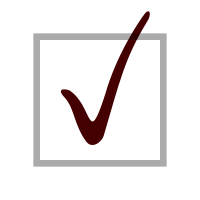- Tick (check mark)
-
A tick (known as a check mark or check in North American English) is a mark (✓, ✔, ☑, etc.) used to indicate the concept "yes", for example "yes; this has been verified" or, "yes; that is the correct answer". The x mark is also sometimes used for this purpose (most notably on election ballot papers), but otherwise usually indicates "no", incorrectness, or failure.
As a verb, to tick (off) or to check (off) means to add such a mark. It is quite common, especially on printed forms, printed documents, and computers (see check box), for there to be squares in which to place ticks.
Contents
International differences
In some countries (e.g., Finland, Sweden, Puerto Rico, and Japan)[citation needed], the tick can be used as an error mark and indicates "no" rather than "yes". For example, it is common in Swedish schools for a ✓ to indicate that an answer is incorrect. This often causes confusion as to whether something that has been ticked is correct or incorrect, especially when reading English media. In Finnish, ✓ stands for väärin i.e. "wrong".
Asian replacement
In Japan, an "O Mark" (in the appearance of a circle, Unicode symbol "◯"), also known as "丸印" marujirushi, is used instead of a tick to mean "yes"; this symbol is also used in Taiwan, Korea and China.[citation needed] A tick placed in brackets can mean a previously used or acceptable fact or definition is being looked into, usually for the purpose of expanding academic research.[citation needed]
A rainbow-colored tick was also used for the Amiga logo during the Commodore era of the Amiga (1985–1994).
Unicode
Unicode provides various related symbols, including:
- U+2713 ✓ check mark
- U+2714 ✔ heavy check mark
- U+2610 ☐ ballot box
- U+2611 ☑ ballot box with check
See also
- Brackets
- Tally marks
- X mark
External links
Categories:- Pictograms
Wikimedia Foundation. 2010.

